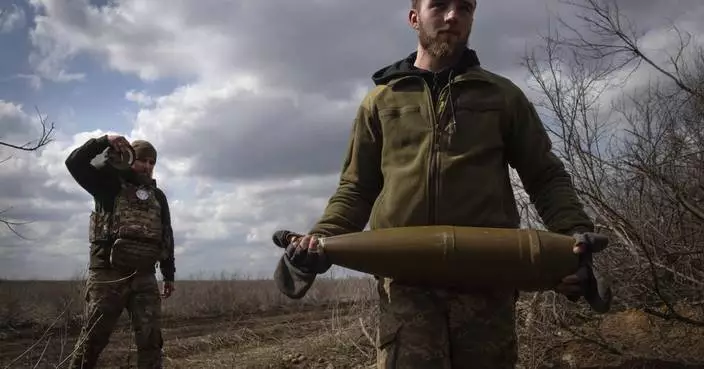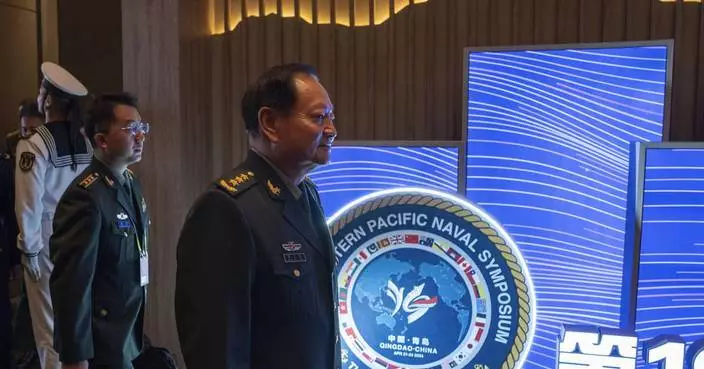Hunkered down behind a wall of snow, two U.S. Marines melt slush to make drinking water after spending the night digging out a defensive position high in the Sierra Nevada. Their laminated targeting map is wedged into the ice just below the machine gun.
Nearly 8,000 feet up at a training center in the California mountains, the air is thin, the snow is chest high and the temperature is plunging. But other Marines just a few kilometers away are preparing to attack, and forces on both sides must be able to battle the enemy and the unforgiving environment.
Click to Gallery
Hunkered down behind a wall of snow, two U.S. Marines melt slush to make drinking water after spending the night digging out a defensive position high in the Sierra Nevada. Their laminated targeting map is wedged into the ice just below the machine gun.
"We haven't had to deal with these things. We've been very focused on Iraq and Afghanistan," said Maj. Gen. William F. Mullen, head of the Marines' Training and Education Command. "What we really have to do is wake folks up, expose them to things that they haven't had to think about for quite a while."
As a snowstorm swirls around them, Mullen and Hutchison move through the woods, checking in with the young Marines designated as the adversary force of about 250 troops who must prevent more than 800 attackers from gaining control of nearby Wolf Creek Bridge. An Associated Press team was allowed to accompany them to the Marine Corps' Mountain Warfare Training Center south of Lake Tahoe and watch the training.
The cold and wet conditions force the Marines to use snowshoes and cross-country skis to get around. They wrap white camouflage around their weapons, struggle to keep the ammunition dry and learn how to position their machine guns so they don't sink into the powdery snow.
Rather than fighting from forward operating bases that stretched across Iraq and Afghanistan, complete with security forces and chow halls, troops now have to be more independent, commanders say, providing their own protection and support. And they must prepare for a more formidable, high-tech enemy.
Back on the mountain, Mullen and Hutchison have seized on that issue. The attacking force, members of 2nd Battalion, 1st Marine Regiment out of Camp Pendleton, California, spotted one of the adversary's fighting positions and fired on it. The simulated attack didn't hurt anyone, but the competition is real for the defending forces from 2nd Battalion, 7th Marine Regiment, out of Twentynine Palms.
In the face of questioning from senior leaders, Dixon held his ground, confident his forces were in the right place to defend the bridge.
The final assessment by the trainers was that the attackers suffered 30-40 percent casualties, while Dixon's troops lost about 10 percent.
U.S. Marines take their positions during advanced cold-weather training at the Marine Corps Mountain Warfare Training Center Sunday, Feb. 10, 2019, in Bridgeport, Calif. After 17 years of war against Taliban and al-Qaida-linked insurgents, the military is shifting its focus to better prepare for great-power competition with Russia and China, and against unpredictable foes such as North Korea and Iran. (AP PhotoJae C. Hong)
A U.S. Marine covers a machine gun in a trench while preparing for advanced cold-weather training at the Marine Corps Mountain Warfare Training Center Saturday, Feb. 9, 2019, in Bridgeport, Calif. After 17 years of war against Taliban and al-Qaida-linked insurgents, the military is shifting its focus to better prepare for great-power competition with Russia and China, and against unpredictable foes such as North Korea and Iran. (AP PhotoJae C. Hong)
A U.S. Marine sits in a trench during advanced cold-weather training at the Marine Corps Mountain Warfare Training Center Saturday, Feb. 9, 2019, in Bridgeport, Calif. After 17 years of war against Taliban and al-Qaida-linked insurgents, the military is shifting its focus to better prepare for great-power competition with Russia and China, and against unpredictable foes such as North Korea and Iran. (AP PhotoJae C. Hong)
A group of U.S. Marines walk along a snow-covered trail during advanced cold-weather training at the Marine Corps Mountain Warfare Training Center Sunday, Feb. 10, 2019, in Bridgeport, Calif. After 17 years of war against Taliban and al-Qaida-linked insurgents, the military is shifting its focus to better prepare for great-power competition with Russia and China, and against unpredictable foes such as North Korea and Iran. (AP PhotoJae C. Hong)
U.S. Marines gather for a debrief during advanced cold-weather training at the Marine Corps Mountain Warfare Training Center Sunday, Feb. 10, 2019, in Bridgeport, Calif. After 17 years of war against Taliban and al-Qaida-linked insurgents, the military is shifting its focus to better prepare for great-power competition with Russia and China, and against unpredictable foes such as North Korea and Iran. (AP PhotoJae C. Hong)
The exercise is designed to train troops for the next war — one the U.S. believes will be against a more capable, high-tech enemy like Russia, North Korea or China. The weather conditions on the mountain mimic the kind of frigid fight that forces could face in one of those future hotspots.
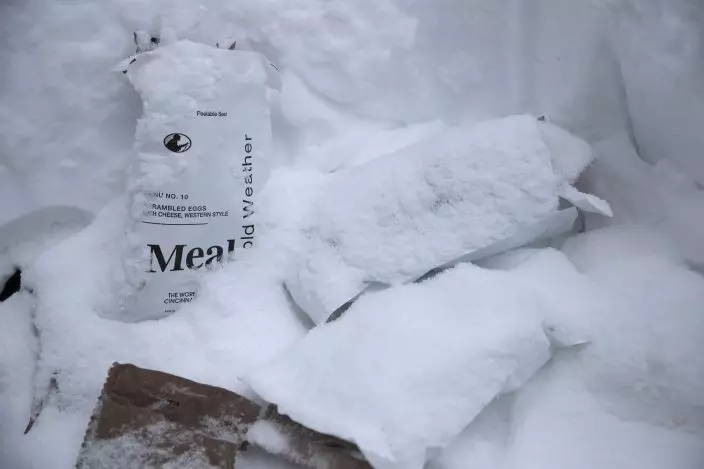
Empty MRE packages are covered in snow as U.S. Marines prepare for advanced cold-weather training at the Marine Corps Mountain Warfare Training Center Saturday, Feb. 9, 2019, in Bridgeport, Calif. After 17 years of war against Taliban and al-Qaida-linked insurgents, the military is shifting its focus to better prepare for great-power competition with Russia and China, and against unpredictable foes such as North Korea and Iran. (AP PhotoJae C. Hong)
"We haven't had to deal with these things. We've been very focused on Iraq and Afghanistan," said Maj. Gen. William F. Mullen, head of the Marines' Training and Education Command. "What we really have to do is wake folks up, expose them to things that they haven't had to think about for quite a while."
After 17 years of war against Taliban and al-Qaida-linked insurgents, the military is shifting its focus to better prepare for great-power competition with Russia and China, and against unpredictable foes such as North Korea and Iran. U.S. forces must be able to survive and fight while countering drones, sophisticated jamming equipment and other electronic and cyber warfare that can track them, disrupt communications and kill them — technology they didn't routinely face over the last decade.
"If you were to draw a line from here to the DMZ between North and South Korea, both of these sites are on the 38th parallel. And so the weather here accurately replicates the weather that we would encounter in North and South Korea," said Col. Kevin Hutchison, the training center commander. "What you're seeing here is Marines fighting Marines, so we are replicating a near-peer threat."
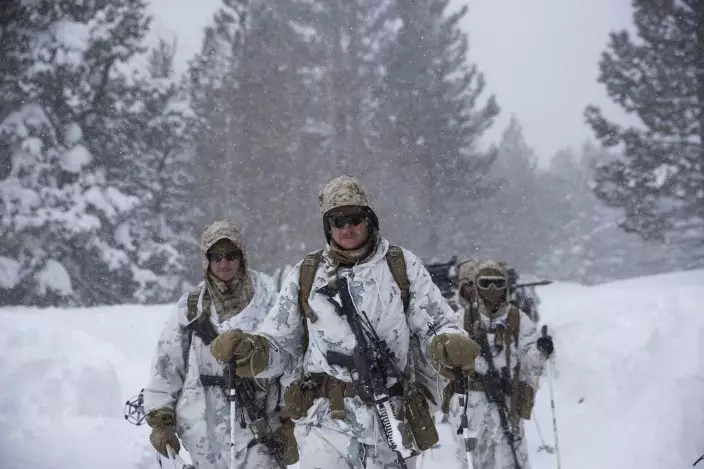
U.S. Marines walk along a snow-covered trail during their advanced cold-weather training at the Marine Corps Mountain Warfare Training Center Sunday, Feb. 10, 2019, in Bridgeport, Calif. After 17 years of war against Taliban and al-Qaida-linked insurgents, the military is shifting its focus to better prepare for great-power competition with Russia and China, and against unpredictable foes such as North Korea and Iran. (AP PhotoJae C. Hong)
As a snowstorm swirls around them, Mullen and Hutchison move through the woods, checking in with the young Marines designated as the adversary force of about 250 troops who must prevent more than 800 attackers from gaining control of nearby Wolf Creek Bridge. An Associated Press team was allowed to accompany them to the Marine Corps' Mountain Warfare Training Center south of Lake Tahoe and watch the training.
Lance Cpl. Reese Nichols, from Pensacola, Florida, and Lance Cpl. Chase Soltis of Bozeman, Montana, dug their defensive position a day ago, and they've been watching all night for enemy movement, while using a small burner to melt snow to stay hydrated.
The hardest part, said Nichols, is "boiling water 24/7. And the cold. It's cold."
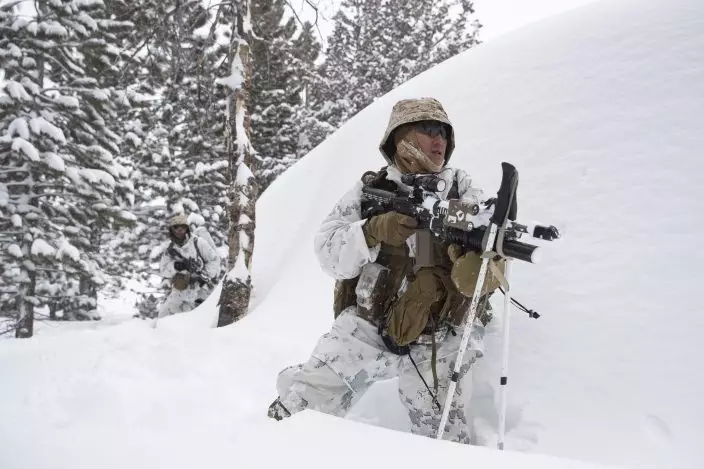
A U.S. Marine takes his position during advanced cold-weather training at the Marine Corps Mountain Warfare Training Center Sunday, Feb. 10, 2019, in Bridgeport, Calif. After 17 years of war against Taliban and al-Qaida-linked insurgents, the military is shifting its focus to better prepare for great-power competition with Russia and China, and against unpredictable foes such as North Korea and Iran. (AP PhotoJae C. Hong)
The cold and wet conditions force the Marines to use snowshoes and cross-country skis to get around. They wrap white camouflage around their weapons, struggle to keep the ammunition dry and learn how to position their machine guns so they don't sink into the powdery snow.
"It's kind of overwhelming coming up here. Many of them have never been exposed to snow before," said Staff Sgt. Rian Lusk, chief instructor for the mountain sniper course. "You're constantly having to dig or move up the mountain range. So, it's physically taxing, but more than anything, I think, it's mentally taxing."
The Marine Corps has changed its training in the mountain course and at Twentynine Palms Marine base 400 miles south. Instead of scripted exercises, trainers map out general objectives and let the Marines make their own battle decisions, replicating a more unpredictable combat situation.
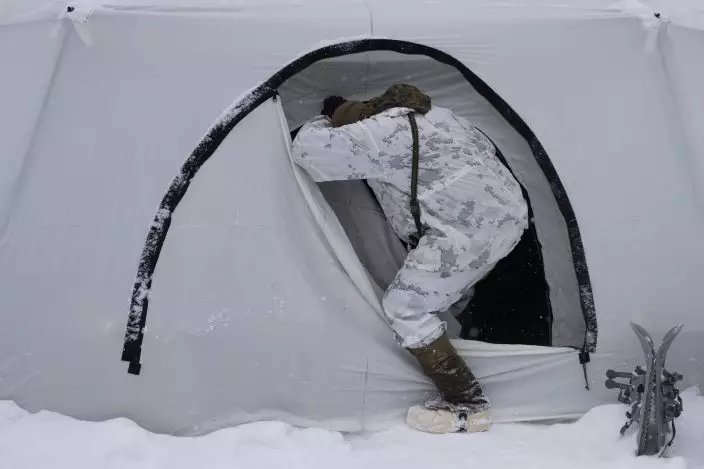
A U.S. Marine walks into a tent during advanced cold-weather training at the Marine Corps Mountain Warfare Training Center Saturday, Feb. 9, 2019, in Bridgeport, Calif. After 17 years of war against Taliban and al-Qaida-linked insurgents, the military is shifting its focus to better prepare for great-power competition with Russia and China, and against unpredictable foes such as North Korea and Iran. (AP PhotoJae C. Hong)
Rather than fighting from forward operating bases that stretched across Iraq and Afghanistan, complete with security forces and chow halls, troops now have to be more independent, commanders say, providing their own protection and support. And they must prepare for a more formidable, high-tech enemy.
Mullen recalled speaking to a commander in Ukraine in the aftermath of Russia's annexation of Crimea. "He said that within two minutes of keying his handset he had rockets coming in on his position," said Mullen, who spent two days at Twentynine Palms, watching a battlefield exercise, before flying to the Bridgeport base in California's Toiyabe National Forest.
The key in both places, said Mullen, is whether the Marines can stay undetected and adjust their battle plan quickly when faced with unexpected threats.

Maj. Gen. William F. Mullen, head of the Marine's Training and Education Command, listens to a debrief during advanced cold-weather training at the Marine Corps Mountain Warfare Training Center Sunday, Feb. 10, 2019, in Bridgeport, Calif. (AP PhotoJae C. Hong)
Back on the mountain, Mullen and Hutchison have seized on that issue. The attacking force, members of 2nd Battalion, 1st Marine Regiment out of Camp Pendleton, California, spotted one of the adversary's fighting positions and fired on it. The simulated attack didn't hurt anyone, but the competition is real for the defending forces from 2nd Battalion, 7th Marine Regiment, out of Twentynine Palms.
"You took casualties today, and you didn't respond to it," Hutchison told the platoon leader, 2nd Lt. Brendan Dixon of Hampton Roads, Virginia.
Why, pressed Mullen, didn't Dixon move his Marines to a safer location?
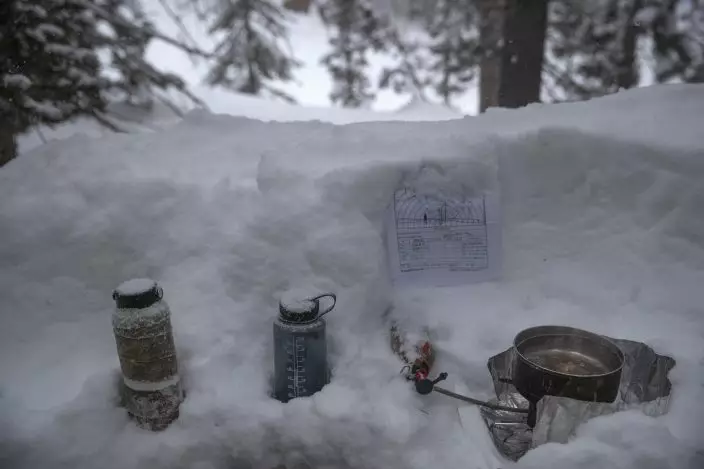
U.S. Marines boils water in a trench during advanced cold-weather training at the Marine Corps Mountain Warfare Training Center Saturday, Feb. 9, 2019, in Bridgeport, Calif. After 17 years of war against Taliban and al-Qaida-linked insurgents, the military is shifting its focus to better prepare for great-power competition with Russia and China, and against unpredictable foes such as North Korea and Iran. (AP PhotoJae C. Hong)
In the face of questioning from senior leaders, Dixon held his ground, confident his forces were in the right place to defend the bridge.
It turns out, he was right.
Moving toward the bridge, the attacking forces became trapped on a ridgeline, exposed to the enemy and unable to move through a ravine filled with snow. Gunfire exploded across the ridge.
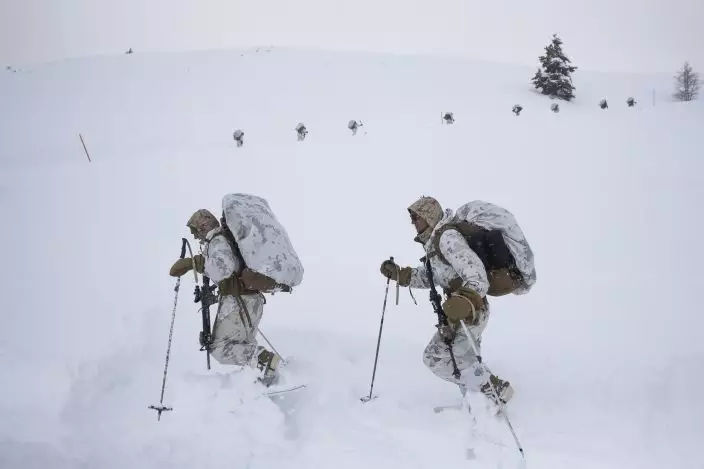
A group of U.S. Marines walk along a snow-covered trail during advanced cold-weather training at the Marine Corps Mountain Warfare Training Center Sunday, Feb. 10, 2019, in Bridgeport, Calif. After 17 years of war against Taliban and al-Qaida-linked insurgents, the military is shifting its focus to better prepare for great-power competition with Russia and China, and against unpredictable foes such as North Korea and Iran. (AP PhotoJae C. Hong)
The final assessment by the trainers was that the attackers suffered 30-40 percent casualties, while Dixon's troops lost about 10 percent.
The attacking force, said Hutchison, made some decisions that would have resulted in Marine deaths in a real battle, but it's better to learn now, than in combat.
"In the Far East, whether it's in northern Europe, etc., we're replicating that here. And what we're finding is, it's an extremely challenging problem," said Hutchison. "And it's a problem that, frankly, if we don't train to, it's going to cost a lot of Marine lives."
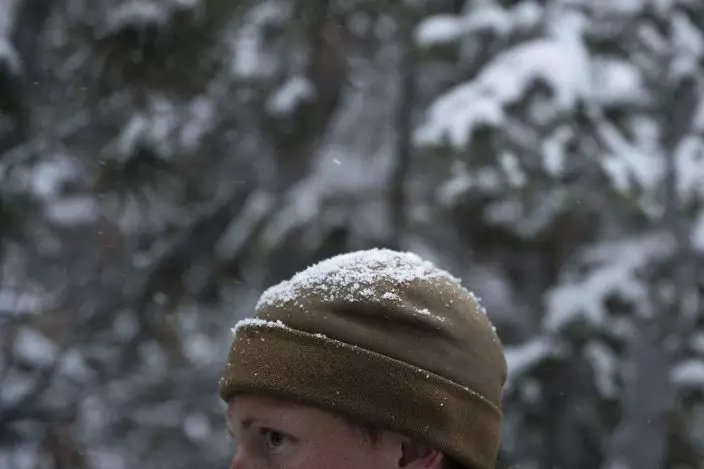
2nd Lt. Brendan Dixon, of Hampton Roads, Va., listens to Col. Kevin Hutchison during advanced cold-weather training at the Marine Corps Mountain Warfare Training Center Saturday, Feb. 9, 2019, in Bridgeport, Calif. After 17 years of war against Taliban and al-Qaida-linked insurgents, the military is shifting its focus to better prepare for great-power competition with Russia and China, and against unpredictable foes such as North Korea and Iran. (AP PhotoJae C. Hong)

U.S. Marines take their positions during advanced cold-weather training at the Marine Corps Mountain Warfare Training Center Sunday, Feb. 10, 2019, in Bridgeport, Calif. After 17 years of war against Taliban and al-Qaida-linked insurgents, the military is shifting its focus to better prepare for great-power competition with Russia and China, and against unpredictable foes such as North Korea and Iran. (AP PhotoJae C. Hong)
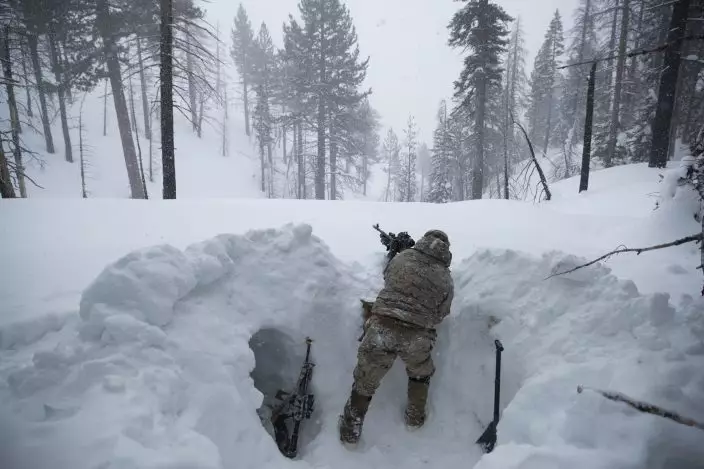
A U.S. Marine covers a machine gun in a trench while preparing for advanced cold-weather training at the Marine Corps Mountain Warfare Training Center Saturday, Feb. 9, 2019, in Bridgeport, Calif. After 17 years of war against Taliban and al-Qaida-linked insurgents, the military is shifting its focus to better prepare for great-power competition with Russia and China, and against unpredictable foes such as North Korea and Iran. (AP PhotoJae C. Hong)
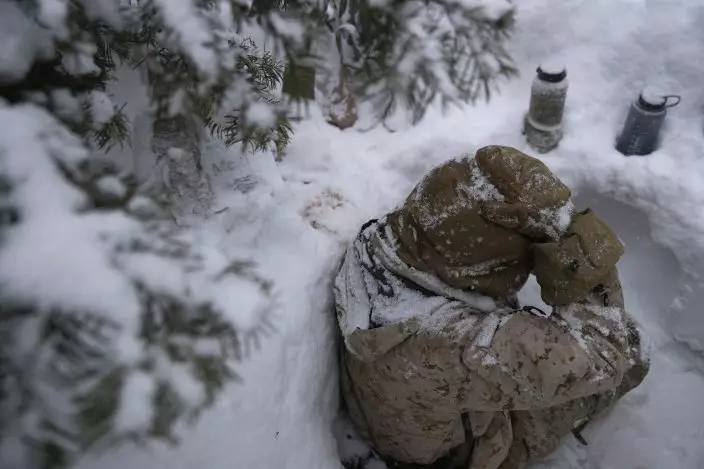
A U.S. Marine sits in a trench during advanced cold-weather training at the Marine Corps Mountain Warfare Training Center Saturday, Feb. 9, 2019, in Bridgeport, Calif. After 17 years of war against Taliban and al-Qaida-linked insurgents, the military is shifting its focus to better prepare for great-power competition with Russia and China, and against unpredictable foes such as North Korea and Iran. (AP PhotoJae C. Hong)
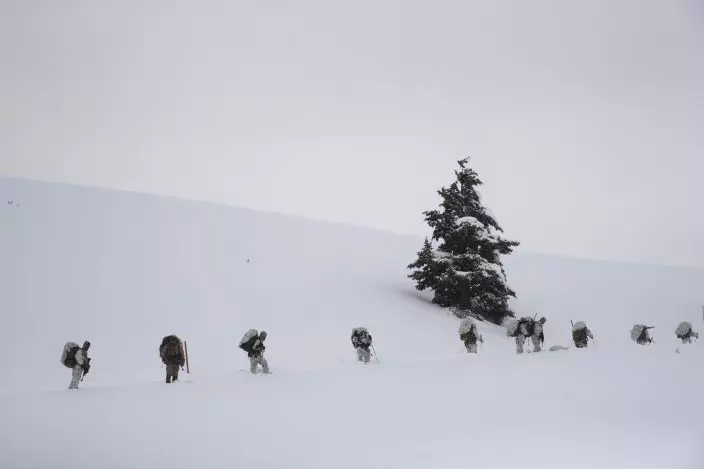
A group of U.S. Marines walk along a snow-covered trail during advanced cold-weather training at the Marine Corps Mountain Warfare Training Center Sunday, Feb. 10, 2019, in Bridgeport, Calif. After 17 years of war against Taliban and al-Qaida-linked insurgents, the military is shifting its focus to better prepare for great-power competition with Russia and China, and against unpredictable foes such as North Korea and Iran. (AP PhotoJae C. Hong)
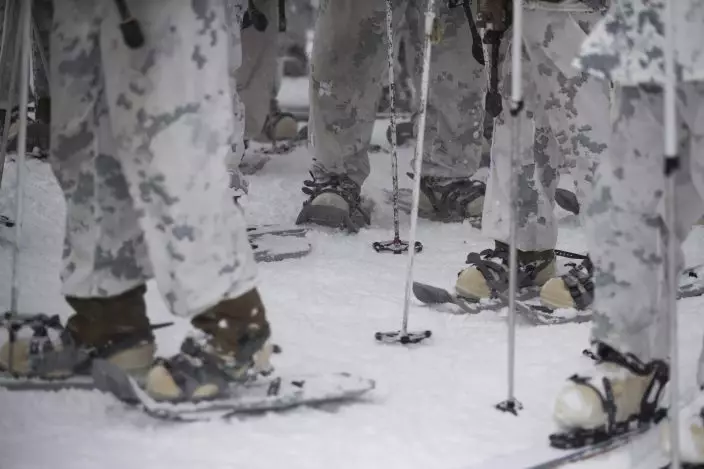
U.S. Marines gather for a debrief during advanced cold-weather training at the Marine Corps Mountain Warfare Training Center Sunday, Feb. 10, 2019, in Bridgeport, Calif. After 17 years of war against Taliban and al-Qaida-linked insurgents, the military is shifting its focus to better prepare for great-power competition with Russia and China, and against unpredictable foes such as North Korea and Iran. (AP PhotoJae C. Hong)
KYIV, Ukraine (AP) — A big, new package of U.S. military aid will help Ukraine avoid defeat in its war with Russia. Winning will still be a long slog.
The arms and ammunition in the $61 billion military aid package should enable Ukraine to slow the Russian army's bloody advances and block its strikes on troops and civilians. And it will buy Ukraine time — for long-term planning about how to take back the fifth of the country now under Russian control.
“Ultimately it offers Ukraine the prospect of staying in the war this year,” said Michael Clarke, visiting professor in war studies at King’s College London. “Sometimes in warfare you’ve just got to stay in it. You’ve just got to avoid being rolled over.”
The U.S. House of Representatives approved the package on Saturday after months of delays by some Republicans wary of U.S. involvement overseas. It was passed by the Senate on Tuesday, and President Joe Biden said he would sign it Wednesday.
The difference could be felt within days on the front line in eastern and southern Ukraine, where Russia’s much larger army has been slowly taking territory against massively outgunned Ukrainian forces.
The aid approval means Ukraine may be able to release artillery ammunition from dwindling stocks that it has been rationing. More equipment will come soon from American stocks in Poland and Germany, and later from the U.S.
The first shipments are expected to arrive by the beginning of next week, said Davyd Arakhamia, a lawmaker with Ukrainian President Volodymyr Zelenskyy’s Servant of the People party.
But opposition lawmaker Vadym Ivchenko, a member of the Ukrainian parliament’s National Security, Defense and Intelligence Committee, said logistical challenges and bureaucracy could delay shipments to Ukraine by two to three months, and it would be even longer before they reach the front line.
While details of the shipments are classified, Ukraine’s most urgent needs are artillery shells to stop Russian troops from advancing, and anti-aircraft missiles to protect people and infrastructure from missiles, drones and bombs.
What’s coming first is not always what front-line commanders need most, said Arakhamia, the Ukrainian lawmaker. He said that even a military giant like the U.S. does not have stockpiles of everything.
“The logic behind this first package was, you (the U.S.) finds our top priorities and then you see what you have in the warehouses,” Arakhamia said. “And sometimes they do not match.”
Hope for future breakthroughs for Ukraine still hangs on more timely deliveries of Western aid, lawmakers acknowledge.
Many experts believe that both Ukraine and Russia are exhausted by two years of war and won’t be able to mount a major offensive — one capable of making big strategic gains — until next year.
Still, Russia is pushing forward at several points along the 1,000-kilometer (600-mile) front, using tanks, wave after wave of infantry troops and satellite-guided gliding bombs to pummel Ukrainian forces. Russia is also hitting power plants and pounding Ukraine’s second-largest city, Kharkiv, which is only about 30 kilometers (some 20 miles) from the Russian border.
Ivchenko said the goal for Ukraine’s forces now is to “hold the line” until the bulk of new supplies arrive by mid-summer. Then, they can focus on trying to recapture territory recently lost in the Donetsk region.
“And probably ... at the end of summer we’ll see some movement, offensive movement of the Ukrainian armed forces,” he said.
Some military experts doubt Ukraine has the resources to mount even small offensives very soon.
The U.S. funding “can probably only help stabilize the Ukrainian position for this year and begin preparations for operations in 2025,” said Matthew Savill, director of military sciences at the Royal United Services Institute, a think tank.
In the best-case scenario for Ukraine, the American aid will give commanders time to reorganize and train its army — applying lessons learned from its failed summer 2023 offensive. It may also galvanize Ukraine’s allies in Europe to increase aid.
“So this just wasn’t about Ukraine and the United States, this really affected our entire 51-country coalition,” said U.S. Congressman Bill Keating, a Democrat who visited Kyiv on Monday as part of a four-member congressional delegation.
Zelenskyy insists Ukraine's war aim is to recapture all its territory from Russia — including Crimea, seized illegally in 2014. Even if the war ultimately ends through negotiation, as many experts believe, Ukraine wants to do that from as strong a position as possible.
Whatever happens on the battlefield, Ukraine still faces variables beyond its control.
Former U.S. President Donald Trump, who seeks to retake the White House in the November election, has said he would end the war within days of taking office. And the 27-nation Europe Union includes leaders like Hungarian President Viktor Orbán and Slovakian Prime Minister Richard Fico, who have opposed arming Ukraine.
Ukraine’s allies have held back from supplying some arms out of concern about escalation or depleting their own stocks. Ukraine says that to win the war it needs longer-range missiles it could use for potentially game-changing operations such as cutting off occupied Crimea, where's Russia's Black Sea fleet is based.
It wants Army Tactical Missile Systems, known as ATACMs, from the U.S. and Taurus cruise missiles from Germany. Both governments have resisted calls to send them because they are capable of striking targets deep within Russian territory.
The new bill authorizes the president to send Ukraine ATACMS “as soon as practicable.” It's unclear what that will mean in practice.
Sometimes, promised weapons have arrived late, or not at all. Zelenskyy recently pointed out that Ukraine is still waiting for the F-16 fighter jets it was promised a year ago.
Meanwhile, Russia is using its advantage in troops and weapons to push back Ukrainian forces, perhaps seeking to make maximum gains before Ukraine's new supplies arrive.
For weeks it has pummeled the small eastern city of Chasiv Yar, at the cost of 900 soldiers killed and wounded a day, according to the U.K. Ministry of Defense.
Capturing the strategically important hill town would allow them to move toward Sloviansk and Kramatorsk, key cities Ukraine controls in the eastern region of Donetsk. It would be a significant win for Russian President Vladimir Putin, who Western officials say is bent on toppling Ukraine’s pro-Western government.
Russian pressure was aimed not just at gaining territory, but on undermining Zelenskyy and bolstering critics who say his war plan is failing, said Clarke of King's College London.
The U.S. aid package decreases the likelihood of a political crisis in Ukraine, and U.S. Speaker Mike Johnson deserves credit for pushing it through Congress, he said.
"He held history in his hands,” Clarke said.
Follow AP’s coverage of the war in Ukraine at https://apnews.com/hub/russia-ukraine

From left, U.S. representatives Nathaniel Moran, R-Tx, Tom Kean Jr, R-NJ, Bill Keating, D-Mass, and Madeleine Deane, D-Pa, talk to journalists during a joint news conference outside Saint Michael cathedral in Kyiv, Ukraine, Monday, April 22, 2024. A newly approved package of $61 billion in U.S. aid may prevent Ukraine from losing its war against Russia. But winning it will be a long slog. (AP Photo/Francisco Seco)
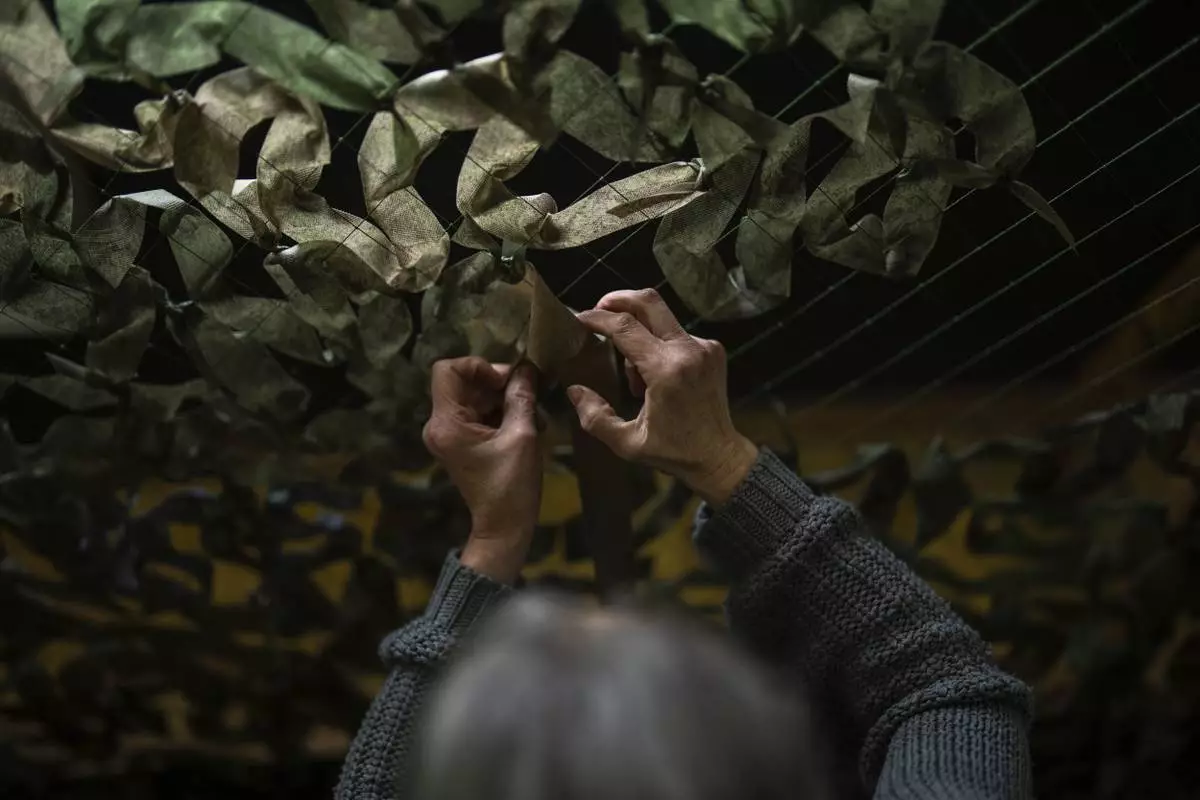
A volunteer makes a camouflage net at a facility producing material for Ukrainian soldiers in Kyiv, Ukraine, Monday, April 22, 2024. A newly approved package of $61 billion in U.S. aid may prevent Ukraine from losing its war against Russia. But winning it will be a long slog. (AP Photo/Francisco Seco)
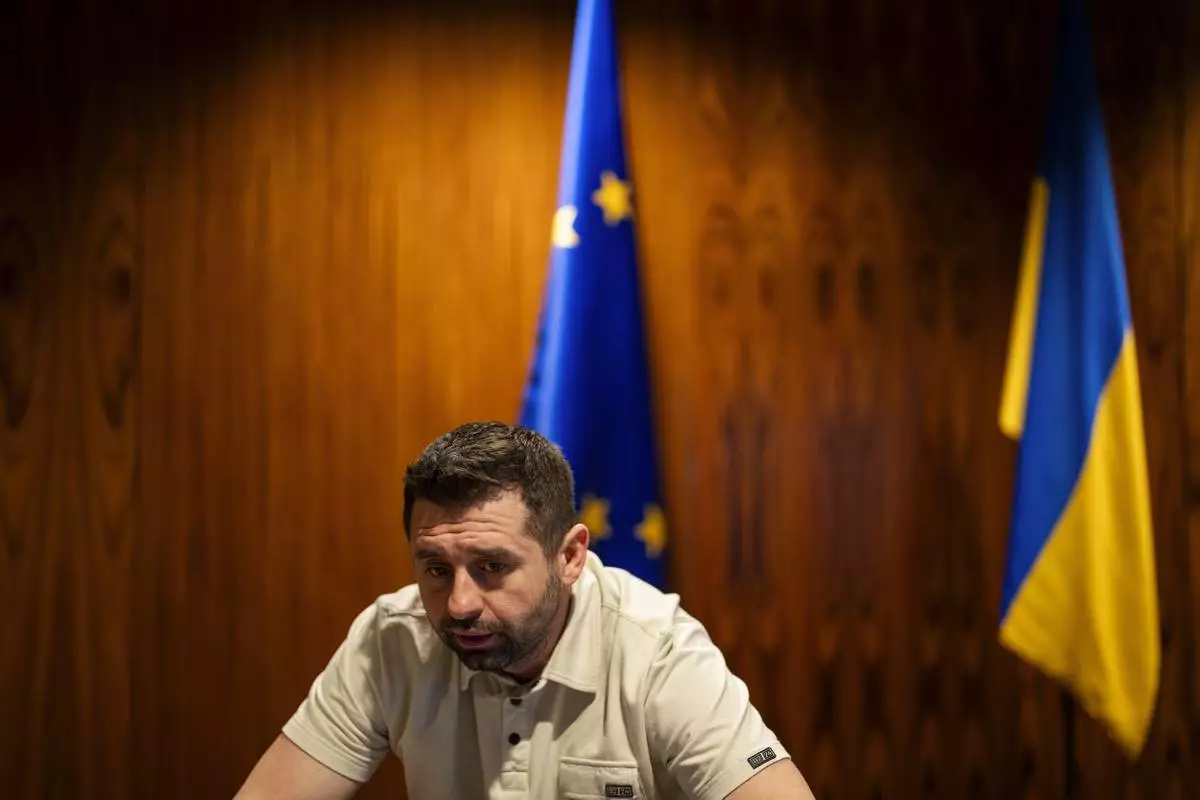
Davyd Arakhamia, a lawmaker with Ukrainian President Volodymyr Zelenskyy's Servant of the People party, talks during an interview with Associated Press in Kyiv, Ukraine, Monday, April 22, 2024. (AP Photo/Francisco Seco)

A woman rallies to raise awareness on the fate of Ukrainian prisoners of war in Kyiv, Ukraine, Sunday, April 21, 2024. (AP Photo/Francisco Seco)
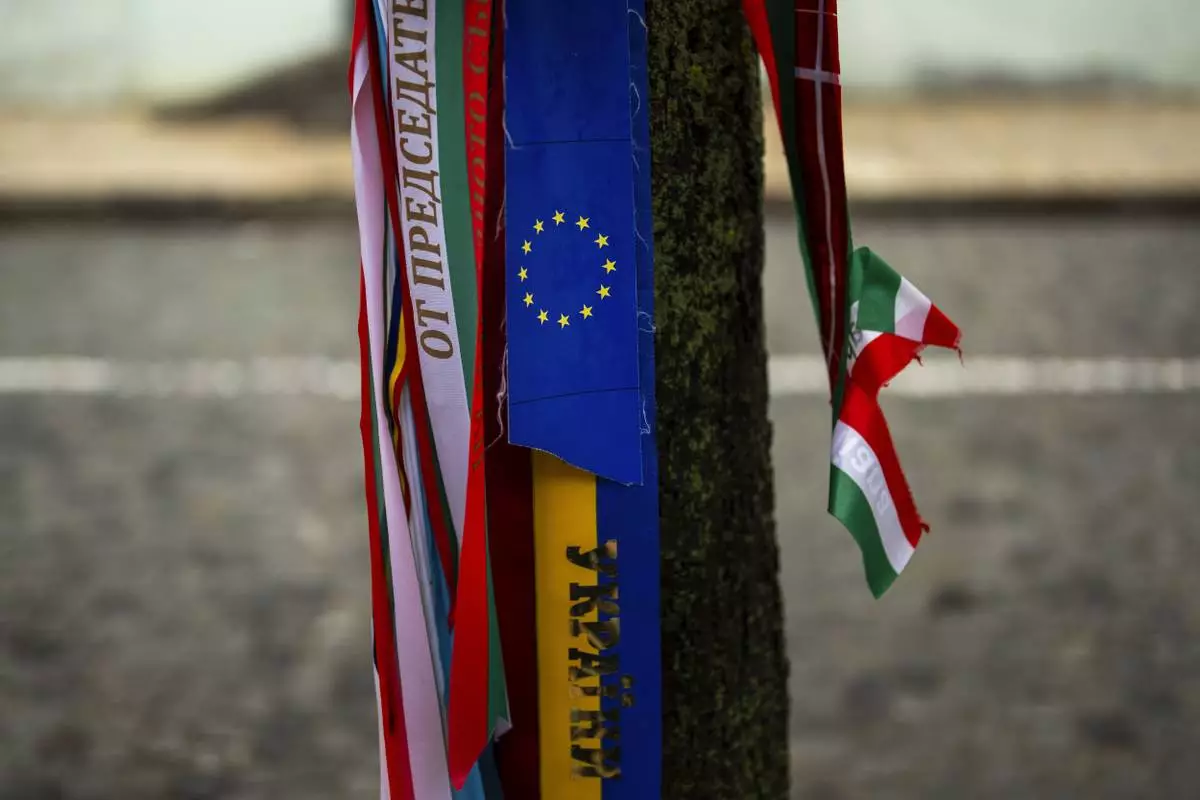
Ribbons with the colors of the European Union and Ukraine are attached to a tree next to memorial wall of Ukrainian soldiers killed during the war in Kyiv, Ukraine, Monday, April 22, 2024. (AP Photo/Francisco Seco)
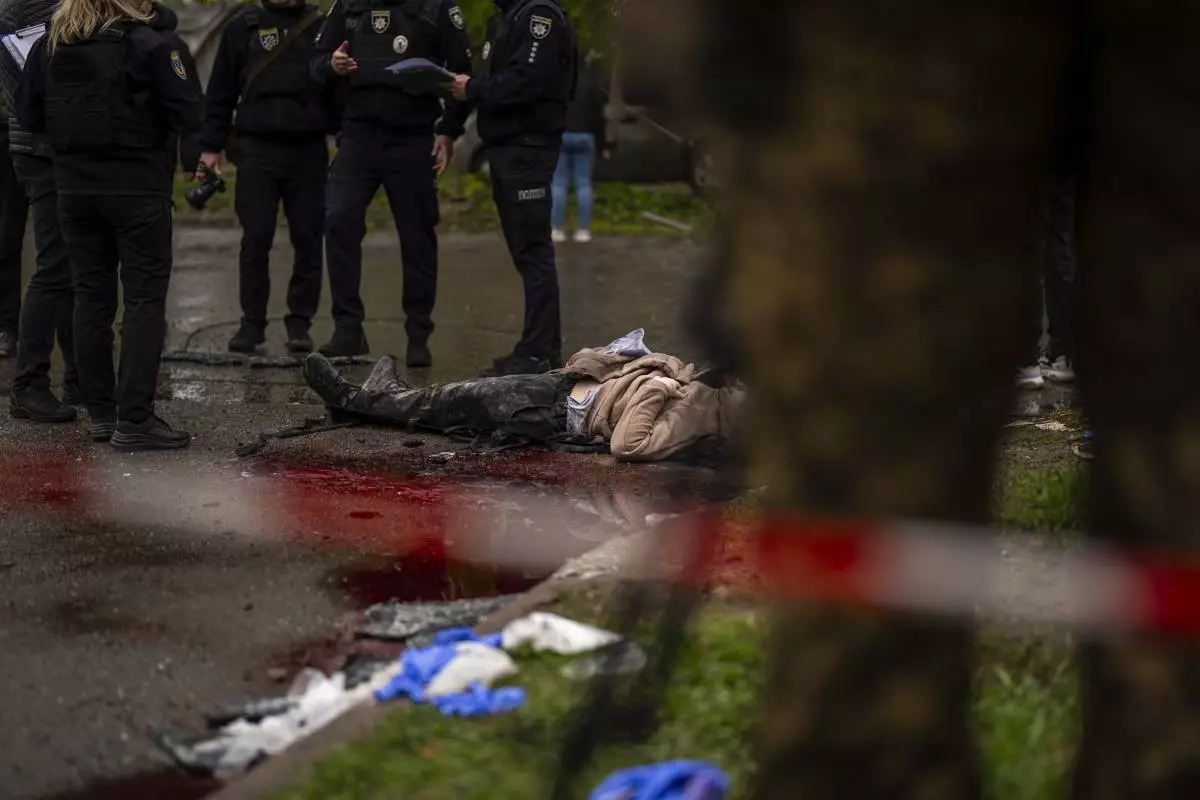
The body of a woman killed by Russian bombardment in Chernihiv, Ukraine, Wednesday, April 17, 2024. (AP Photo/Francisco Seco)

Soldiers carry the coffins of two Ukrainian army sergeants during their funeral in Lviv, Ukraine, Tuesday, April 16, 2024. (AP Photo/Francisco Seco)


























